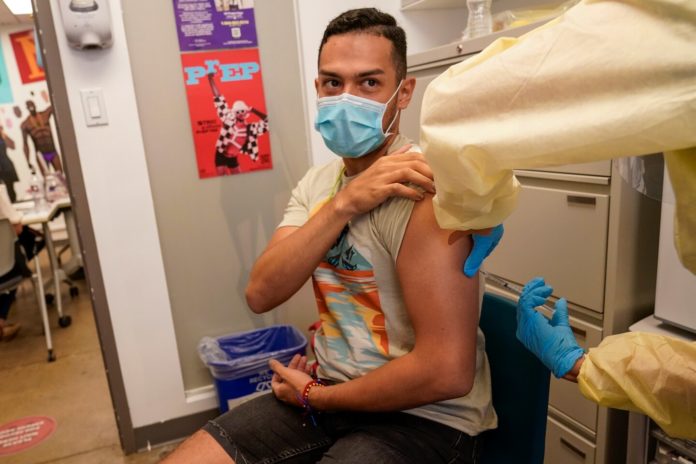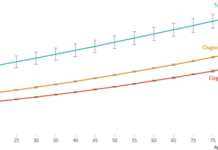
Globally, new cases fell by 21 percent from last week, the World Health Organization reported Thursday.
Even as public health experts cheered the recent slowdown in new infections, they cautioned that the virus continues to pose a risk — especially in smaller communities outside U.S. urban centers and in developing countries amid vaccine shortages, limited surveillance and insufficient testing — and could increasingly spill beyond the gay and bisexual community. Epidemiologist and health officials also report ongoing challenges with the White House’s new vaccine strategy to stretch the number of doses available.
“There are signs that the outbreak is slowing in Europe, where a combination of effective public health measures, behavior change and vaccination are helping to prevent transmission,” WHO Director General Tedros Adhanom Ghebreyesus said Thursday. But he warned that new cases are continuing to increasein Latin America, where there is less awareness of the virus and limited vaccine access.
Anne Rimoin, an epidemiologist at the University of California at Los Angeles who has studied the monkeypox outbreak, said a drop in cases is expected after growing awareness and a push for vaccinations. “Whether or not that’s going to be sustained, we just don’t know,” she said. “It’s premature to declare any kind of victory.”
Biden administration officials said they remain concerned about local trends, as new virus cases in some regions are outpacing urban centers. Monkeypox cases in Georgia climbed 66 percent between Aug. 10 and 24, a two-week period when cases climbed just 41 percent in New York City, according to state and local health department data.
In New York City, the epicenter of the U.S. outbreak, health commissioner Ashwin Vasan said officials are “cautiously optimistic” that the virus is on the retreat, after nearly 2,900 New Yorkers were infected in the past three months. About 40 new cases per day were diagnosed in New York City last week, compared with more than 70 cases per day earlier this month.
“In recent days, we have seen cases begin to fall and transmission slow,” Vasan testified in front of the New York City Council on Wednesday, crediting the rise in vaccinations and change in sexual behaviors. “All of this is clearly taking hold and having a positive effect in slowing this outbreak.” Officials in cities like San Francisco and Chicago have echoed similar messages this week.
The Centers for Disease Control and Prevention reported this week that gay men have modified risky sexual behaviors because of the outbreak, citing an online survey that about half of men who have sex with men said they have reduced one-time sexual encounters as well as reduced sex with partners met on dating apps or at sex venues. The U.S. outbreakwas likely accelerated by a flurry of dance parties and casual sex during June’s Pride Month activities.
“Behavior change, along with vaccination, can help slow the spread and end the monkeypox outbreak.” CDC spokeswoman Kristen Nordlund said in a statement. She noted that U.S. data contains information from many jurisdictions, “some of which continue to have accelerating case counts, and continued vigilance and action remains important.”
State and local health officials are pressing for the Biden administration to provide more support for the response, saying they need additional funding to raise public awareness about the virus, hire extra staff to conduct testing and perform contact tracing, and make further investments to strengthen health departments that have been worn down by two years fighting the coronavirus.
“We appreciate federal agencies’ efforts to provide maximum flexibility to use COVID-19 supplemental funding to address this public health emergency,” Michael Fraser, CEO of the Association of State and Territorial Health Officials, wrote to the White House, in a letter shared with The Washington Post. “However, given the scope and scale of the outbreak… it is clear that this short-term solution is not viable for the long term.”
Fraser told The Post that an additional $500 million to $1 billion would be needed to fund the state and local monkeypox response for the next 12 months. He suggested that the Biden administration craft an emergency funding package with Congress or make more funding available through CDC’s Infectious Disease Rapid Response Reserve Fund.
Experts also continue to voice concerns about the Biden administration’s vaccine strategy to extend limited supply by splitting each single-use vial into five doses through a different injection method. The plan, rapidly finalized on Aug. 9, has been cheered by some local officials as an innovative way to meet surging demand. But many state and local officials are encountering logistical problems implementing it.
“I have now heard multiple reports from my state and local colleagues that it is very difficult to extract five doses from a single vaccine vial,” Caitlin Rivers, a Johns Hopkins epidemiologist, wrote in a post on her Substack page last week, criticizing the abrupt strategy shift. “Taken together, state and local health authorities now have up to one-third fewer doses for use in their communities than they were before the move to intradermal administration.”
The chair of the Senate’s health panel also urged the Department of Health and Human Services to take steps to close “alarming” supply gaps in vaccines, both for the present monkeypox response as well as future outbreaks.
“The Administration must do more to address existing, unacceptable shortages in vaccine supply, institute comprehensive distribution and communication strategies, and develop long-term procurement plans,” Sen. Patty Murray (D-Wash.) wrote in a letter Tuesday to Dawn O’Connell, the assistant HHS secretary who oversees the vaccine stockpile.
The White House has defended its vaccination strategy, saying that about 75 percent of jurisdictions around the country have already adopted the new approach. Splitting the doses into fifths will allow the United States to provide more than 3 million total doses of vaccine, “meaning we are very well-positioned and supplied to meet the demand of the at at-risk population,” according to a White House official who spoke on the condition of anonymity to discuss ongoing policy and internal conversations. CDC officials have previously estimated that at least 3.2 million doses of vaccine would be needed to cover the gay and bisexual men who officials consider at highest risk .
Administration officials also say that despite weeks of complaints of limited vaccine availability, many local officials have yet to fully use their vaccine supply. As of Wednesday, only 11 of the 67 jurisdictions around the country have attested to using at least 85 percent of their vaccine supply, according to the White House official.
Biden officials highlighted their work to avert possible outbreaks, such as a recent incident in which a day-care worker in Illinois tested positive for monkeypox, potentially exposing about 60 people, including several dozen children. The worker also served as a home health aide for one elderly person.
The situation alarmed the White House, fearing an outbreak among children, and Biden administration officials rushed dozens of vaccines to the people who were potentially exposed. Three weeks later, there have been no additional infections linked to the day care worker, Julie Pryde, administrator of the Champaign-Urbana Public Health District, told The Post.
Lena H. Sun contributed to this report.








